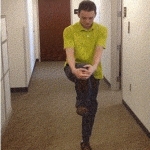“Stretching can help your body get ready for exercise. It is also an essential part of recovering from aerobic activity. All exercise sessions should end with stretching — and not just for the mental relaxation benefits.
Increasing your flexibility improves your ability to move easily and can reduce your risk for injury.”- OrthoInfo
There are three major types of stretches.
1. Static Stretching:

Static is a long, sustained stretching exercise to focus on lengthening the muscles in order to gain more flexibility. Static stretching is usually done following exercising to help relax the muscles and to gain flexibility. This is typically done at the end of a work out to keep the muscles from becoming stiff and tight.
2. Dynamic Stretching:

“Dynamic movement stretches are designed to take a joint or a muscle through a challenging and repetitive motion, moving a body part further with each repetition.”-Runners World
This type of stretching is preferably performed as a warm up to exercising or sports activities. This is the preferred stretching and warm up routine for performance athletes.
It is used to gradually lengthen the muscles in a slow and controlled movement. Unlike ballistic stretching.
3. Ballistic Stretching:

It used to be thought that ballistic stretching was good for warm up routine but the uncontrolled force being expelled while doing this type of stretching raises the risk of injuries.
“Ballistic stretching uses the momentum of a moving body or a limb in an attempt to force it beyond its normal range of motion, by bouncing into (or out of) a stretched position, using the stretched muscles as a spring which pulls you out of the stretched position. (e.g. bouncing down repeatedly to touch your toes.) This type of stretching is not considered useful and can lead to injury.”-MIT
The important thing is to maintain a home stretching program. “Stretching can help improve flexibility, and, consequently, range of motion in your joints. Better flexibility may improve your performance in physical activities or decrease your risk of injuries by helping your joints move through their full range of motion and enabling your muscles to work most effectively.”(MAYO Clinic)
Author: Stephanie Jones, AT
Source:
http://orthoinfo.aaos.org/topic.cfm?topic=a00310
http://web.mit.edu/tkd/stretch/stretching_4.html
http://www.mayoclinic.org/healthy-lifestyle/fitness/in-depth/stretching/art-20047931

